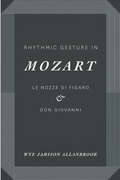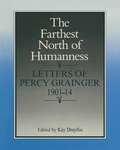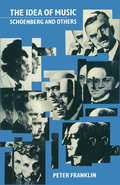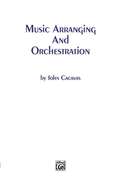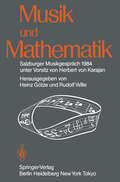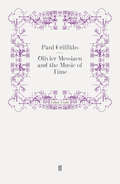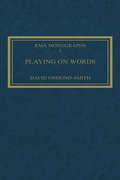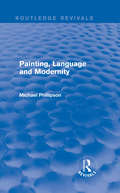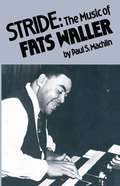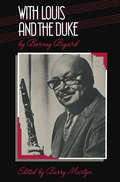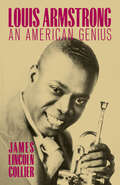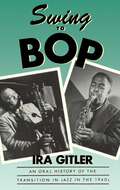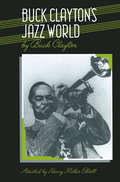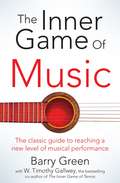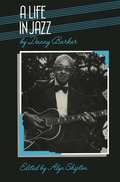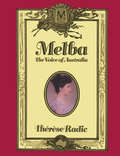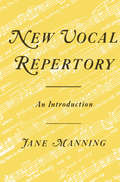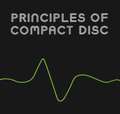- Table View
- List View
Rhythmic Gesture in Mozart: Le Nozze di Figaro and Don Giovanni
by Wye Jamison AllanbrookWye Jamison Allanbrook’s widely influential Rhythmic Gesture in Mozart challenges the view that Wolfgang Amadeus Mozart’s music was a “pure play” of key and theme, more abstract than that of his predecessors. Allanbrook’s innovative work shows that Mozart used a vocabulary of symbolic gestures and musical rhythms to reveal the nature of his characters and their interrelations. The dance rhythms and meters that pervade his operas conveyed very specific meanings to the audiences of the day.
Rhythmic Gesture in Mozart: Le Nozze di Figaro and Don Giovanni
by Wye Jamison AllanbrookWye Jamison Allanbrook’s widely influential Rhythmic Gesture in Mozart challenges the view that Wolfgang Amadeus Mozart’s music was a “pure play” of key and theme, more abstract than that of his predecessors. Allanbrook’s innovative work shows that Mozart used a vocabulary of symbolic gestures and musical rhythms to reveal the nature of his characters and their interrelations. The dance rhythms and meters that pervade his operas conveyed very specific meanings to the audiences of the day.
Rhythmic Gesture in Mozart: Le Nozze di Figaro and Don Giovanni
by Wye Jamison AllanbrookWye Jamison Allanbrook’s widely influential Rhythmic Gesture in Mozart challenges the view that Wolfgang Amadeus Mozart’s music was a “pure play” of key and theme, more abstract than that of his predecessors. Allanbrook’s innovative work shows that Mozart used a vocabulary of symbolic gestures and musical rhythms to reveal the nature of his characters and their interrelations. The dance rhythms and meters that pervade his operas conveyed very specific meanings to the audiences of the day.
Rhythmic Gesture in Mozart: Le Nozze di Figaro and Don Giovanni
by Wye Jamison AllanbrookWye Jamison Allanbrook’s widely influential Rhythmic Gesture in Mozart challenges the view that Wolfgang Amadeus Mozart’s music was a “pure play” of key and theme, more abstract than that of his predecessors. Allanbrook’s innovative work shows that Mozart used a vocabulary of symbolic gestures and musical rhythms to reveal the nature of his characters and their interrelations. The dance rhythms and meters that pervade his operas conveyed very specific meanings to the audiences of the day.
The Idea of Music: Schoenberg and others
by P. FranklinWhy has modern music evolved as it has? Why is it that certain leading composers from the first half of this century are now considered insignificant, while the responsibility for the development of a musical language of modernism has been attributed to Schoenberg and the Second Viennese School? In this book the author seeks to re-examine Schoenberg's innovations through a reassessment of the nature of artistic expression and artistic truth. Starting from the premise that Austro-German music in the late nineteenth century was dominated by philosophical ideas, he has focused on writing by Schoenberg, Adorno and Thomas Mann, setting these alongside a discussion of the music of Pfitzner, Schreker, Mahler, Richard Strauss and Schoenberg himself, in a compelling argument for a review of the standard historical account of the period.
Music Arranging And Orchestration
by John CacavasOrchestrating is a highly complex technique and to many, even those with academic training, a mystery fraught with a labyrinth of hazards. What is required, along with innate talent and general musicality, is the practical "know how." This is hard to achieve without actual professional experience and contact with "live" orchestras. To this end, John Cacavas contributes his extensive experience and ability with a practical approach to the practical problems of orchestrating. It is in this context most orchestrators must function, and to whom this book should be of benefit. The author has been a "musical activist" in all the varied aspects of instrumental combination from the "classical" to the "contemporary," and in the diverse application of his skills in all the media that utilize music and "orchestrations."
Musik und Mathematik: Salzburger Musikgespräch 1984 unter Vorsitz von Herbert von Karajan
by Heinz Götze Rudolf WilleOlivier Messiaen and the Music of Time
by Paul GriffithsOlivier Messiaen was one of the outstanding creative artists of his time. The strength of his appeal, to listeners as well as to composers, is a measure of the individuality of his music, which draws on a vast range of sources: rhythms of twentieth-century Europe and thirteenth-century India, ripe romantic harmony and brittle birdsong, the sounds of Indonesian percussion and modern electronic instruments. What binds all these together is, on one level, his unswerving devotion to praising God in his art, and on another, his independent view of how music is made. Messiaen's music offers a range of ways of experiencing time: time suspended in music of unparalleled changelessness, time racing in music of wild exuberance, time repeating itself in vast cycles of reiteration.In Olivier Messiaen and the Music of Time, leading writer and musicologist, Paul Griffiths, explores the problems of religious art, and includes searching analyses and discussions of all the major works, suggesting how they function as works of art and not only as theological symbols. This comprehensive and stimulating book covers the whole of Messiaen's output up to and including his opera, Saint Fran�oise d'Assise.
Playing on Words: A Guide to Luciano Berio's Sinfonia (Royal Musical Association Monographs)
by David Osmond-SmithLuciano Berio's Sinfonia (1968) marked a return by the composer to orchestral writing after a gap of six years. This in-depth study demonstrates the central position the work occupies in Berio's output. David Osmond-Smith discusses the way in which Berio used the Bororo myth described in Levi-Strauss's Le cru et le cuit as a framework for Sinfonia. This is one of many influences in the work, which also include Joyce's 'Sirens' chapter from Ulysses, Beckett's The Unnameable and the scherzo from Mahler's 2nd Symphony. The listener who takes refuge in the score of Sinfonia, argues Osmond-Smith, finds there a maze of allusions to things beyond the score. It is some of those allusions that this book seeks to illuminate.
Playing on Words: A Guide to Luciano Berio's Sinfonia (Royal Musical Association Monographs)
by David Osmond-SmithLuciano Berio's Sinfonia (1968) marked a return by the composer to orchestral writing after a gap of six years. This in-depth study demonstrates the central position the work occupies in Berio's output. David Osmond-Smith discusses the way in which Berio used the Bororo myth described in Levi-Strauss's Le cru et le cuit as a framework for Sinfonia. This is one of many influences in the work, which also include Joyce's 'Sirens' chapter from Ulysses, Beckett's The Unnameable and the scherzo from Mahler's 2nd Symphony. The listener who takes refuge in the score of Sinfonia, argues Osmond-Smith, finds there a maze of allusions to things beyond the score. It is some of those allusions that this book seeks to illuminate.
Routledge Revivals: Painting, Language and Modernity (1985)
by Michael PhillipsonFirst published in 1985, this book draws together the author’s artistic with analytical practices which had been developed over many years of sociological enquiry. It interprets a ‘work of art’ as a site on which a viewer or critic is invited to share in questioning celebration of the painting itself. The author reassesses modern painting’s relation to its own origins and to tradition in light of the emergence of ‘postmodern’ practice — exploring its engagement of fundamental questions about language and being. Also assessed is the relevance of the metaphors of writings and Reading to an understanding of painting and viewing practices — looking at painters’ writings as well as phenomenological and post-structuralist writers.
Routledge Revivals: Painting, Language and Modernity (1985)
by Michael PhillipsonFirst published in 1985, this book draws together the author’s artistic with analytical practices which had been developed over many years of sociological enquiry. It interprets a ‘work of art’ as a site on which a viewer or critic is invited to share in questioning celebration of the painting itself. The author reassesses modern painting’s relation to its own origins and to tradition in light of the emergence of ‘postmodern’ practice — exploring its engagement of fundamental questions about language and being. Also assessed is the relevance of the metaphors of writings and Reading to an understanding of painting and viewing practices — looking at painters’ writings as well as phenomenological and post-structuralist writers.
Stride: The Music of Fats Waller
by Paul S MachlinAlready known as a Wagner scholar for his work on the sketches of the Flying Dutchman, Paul Machlin has for many years taken a scholarly interest in the school of Harlem 'stride' jazz pianists. Stride: The Music of Fats Waller is a full analysis of the piano music of Waller as composer, soloist and recording artist. 38 music examples illustrate Waller's complex keyboard style and improvisatory techniques. The discussion of Waller's piano music is set in the context of a biographical study, and a discography listing all known recordings by the pianist.
With Louis and the Duke: The Autobiography of a Jazz Clarinetist (Macmillan Popular Music Ser.)
by Barney Bigard Barry MartynLouis Armstrong: An American Genius
by James Lincoln CollierLouis Armstrong. "Satchmo." To millions of fans, he was just a great entertainer. But to jazz aficionados, he was one of the most important musicians of our times--not only a key figure in the history of jazz but a formative influence on all of 20th-century popular music. Set against the backdrop of New Orleans, Chicago, and New York during the "jazz age", Collier re-creates the saga of an old-fashioned black man making it in a white world. He chronicles Armstrong's rise as a musician, his scrapes with the law, his relationships with four wives, and his frequent feuds with fellow musicians Earl Hines and Zutty Singleton. He also sheds new light on Armstrong's endless need for approval, his streak of jealousy, and perhaps most important, what some consider his betrayal of his gift as he opted for commercial success and stardom. A unique biography, knowledgeable, insightful, and packed with information, it ends with Armstrong's death in 1971 as one of the best-known figures in American entertainment.
Swing to Bop: An Oral History of the Transition in Jazz in the 1940s
by Ira GitlerThis indispensable book brings us face to face with some of the most memorable figures in jazz history and charts the rise and development of bop in the late 1930s and '40s. Ira Gitler interviewed more than 50 leading jazz figures, over a 10-year period, to preserve for posterity their recollections of the transition in jazz from the big band era to the modern jazz period. The musicians interviewed, including both the acclaimed and the unrecorded, tell in their own words how this renegade music emerged, why it was a turning point in American jazz, and how it influenced their own lives and work. Placing jazz in historical context, Gitler demonstrates how the mood of the nation in its post-Depression years, racial attitudes of the time, and World War II combined to shape the jazz of today.
The Inner Game Of Music
by Barry Green W. Timothy GallweyThe bestselling guide to improving musical performanceThe Inner Game of Music is the battle that all musicians have to fight against elusive opponents such as nervousness, self-doubt and fear of failure. Using the world-famous Inner Game principles, developed by bestselling author Timothy Gallwey, acclaimed musician Barry Green explains the basic principles of 'natural learning' and shows how you can apply them to reach a new level of musical application and performance. In precise, easy to understand language, Green and Gallwey explain how natural skills - such as awareness, trust and willpower - can be nurtured and enhanced. Through a series of tailored exercises The Inner Game of Music demonstrates the ways in which musicians can achieve exact intonations, artistic phrasing and improved technique. There are also chapters on ensemble playing, improvisation, composition and creativity, as well as listening skills - an essential part of the Inner Game. Following a methodology with a proven track record for generations of aspiring and professional musicians, The Inner Game of Music is invaluable to anyone seriously interested in music, and is guaranteed to deliver positive results whether you are a student, teacher, performer, or simply an appreciative listener.
The Language Electroacoustic Music
by Simon EmmersonSince the inception of electroacoustic music in 1948, much has been written about technical developments. This book is one of the first to examine aesthetic issues central to this rapidly developing genre. It brings together composers from leading academic departments and studios in Britain, the United States, Canada and Paris with a wide range of approaches and opinions, resulting in a study which is likely to have a marked impact on current debates on the future of electroacoustic music. The book is divided into three sections. The first, Culture and Language, considers the relationship between music and the listener's perception and expectation. Materials and Lanugage looks at the types of materials available to composers and the way in which the internal structure of the sound can have implications for the overall structure of a piece. The final section, The Influence of New Technology, considers the relationship between computer systems and the music they are helping to create.
A Life in Jazz
by Danny Barker Alyn ShiptonAs a musician who grew up in New Orleans, and later worked in New York with the major swing orchestras of Lucky Millinder and Cab Calloway, Barker is uniquely placed to give an authoritative but personal view of jazz history. In this book he discusses his life in music, from the children's 'spasm' bands of the seventh ward of New Orleans, through the experience of brass bands and jazz funerals involving his grandfather, Isidore Barbarin, to his early days on the road with the blues singer Little Brother Montgomery. Later he goes on to discuss New York, and the jazz scene he found there in 1930. His work with Jelly Roll Morton, as well as the lesser-known bands of Fess Williams and Albert Nicholas, is covered before a full account of his years with Millinder, Benny Carter and Calloway, including a description of Dizzy Gillespie's impact on jazz, is given. The final chapters discuss Barker's career from the late 1940s. Starting with the New York dixieland scene at Ryan's and Condon's he talks of his work with Wilbur de Paris, James P. Johnson and This is Jazz, before discussing his return to New Orleans and New Orleans Jazz Museum. A collection of Barker's photographs,
Melba: The Voice of Australia
by Therese RadicA biography of the world-famous opera singer Dame Nellie Melba, this book provides fresh insights into her character and motivations. It describes her childhood in Australia, her studies in Paris, her rise to fame and the fascination which she inspired up to the time of the mysterious illness which caused her death. Melba is presented as a shrewd, self-made woman, financially and personally independent. She managed her greatest asset - her voice - and her earnings cleverly so that the voice lasted the distance of a long and strenuous career, and her investments enabled her to enjoy life on a grand scale. She dictated the terms of her own life and rose to unsurpassed heights in her chosen profession. The book's large format enables the main text to be supplemented by lengthy footnotes running down the outside margins, providing additional historical and anecdotal information.
Music, Musicians, and the Saint-Simonians
by Ralph P. LockeThe Saint-Simonians, whose movement flourished in France between 1825 and 1835, are widely recognized for their contributions to history and social thought. Until now, however, no full account has been made of the central role of the arts in their program. In this skillful interdisciplinary study, Ralph P. Locke describes and documents the Saint-Simonians' view of music as an ideological tool and the influence of this view on musical figures of the day. The disciples of Claude Henri de Rouvroy, comte de Saint-Simon, believed that increased industrial production would play a crucial role in improving the condition of the working masses and in shifting power from the aristocratic "drones" to the enterprising men of talent then rising in the French middle class. As a powerful means of winning support for their views, music became an integral part of the Saint-Simonians' writings and ceremonial activities. Among the musicians Locke discusses are Berlioz, Liszt, and Mendelssohn, whose tangential association with the Saint-Simonians reveals new aspects of their social and aesthetic views. Other musicians became the Saint-Simonians' faithful followers, among them Jules Vinçard, Dominique Tajan-Rogé, and particularly Félicien David, the movement's principal composer. Many of these composers' works, reconstructed by Locke from authentic sources, are printed here, including the "Premier Chant des industriels," written at Saint-Simon's request by Rouget de Lisle, composer of the "Marseillaise."
New Vocal Repertory: An Introduction
by Jane ManningAn introduction to 70 songs from the contemporary vocal repertoire which provides advice on performance and suggestions on programming. It is designed for young singers and singing students.
